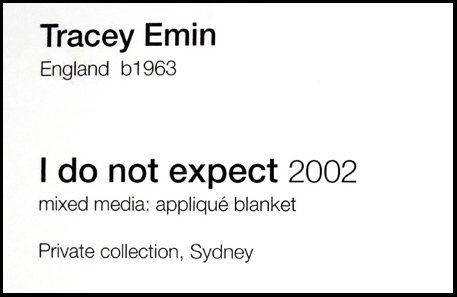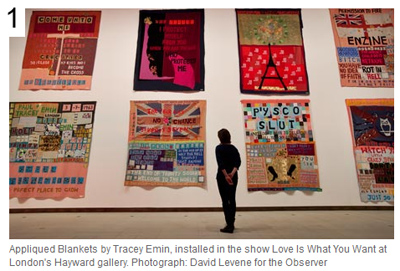 Above: Wall plaque mounted aside art piece , Art Gallery of NSW, 13th December 2013.
Above: Wall plaque mounted aside art piece , Art Gallery of NSW, 13th December 2013.
I also ‘do not expect’ to walk into our State gallery and be confronted with a huge example of Tracey Emin’s work just as I’m considering my research options. What a lucky shot. Whilst permission was granted for photographs, no flash, the same wasn’t given for a chair to be placed in the gallery so I could sit and contemplate her work – 2 pieces on show – so I sat smack in the middle of the floor surrounded by notes, sketchbook and camera. More of an inconvenience to others than sitting on a chair I would have thought, especially as I fidgeted, moved legs forward and back, leaned on elbows, stood, shuffled, leaned against the wall trying to glimpse the back of the work without touching (being under heavy scrutiny) and generally tried to examine all aspects from every angle I could. Never having done an analytical study before and keeping in mind gallery closures over the festive season I didn’t want to miss anything. This was my second visit to this particular piece and, it not having made a particularly favourable impression the first time, I was anxious to look again and try to dissect and understand both it and Tracey Emin more.
Entitled I do not expect and made in 2002 by Tracey Emin this appliquéd blanket, privately owned, is currently hanging completely alone part way along a 20 metre white wall in the lower floor gallery space at AGNSW. The officials informed me, rather uncertainly, that it should be there for around 6 months. Unfortunately, as can be seen from the plaque, no real information is available regarding the item and there is no artist statement. The staff was equally uninformed and the relevant person, probably the curator, was unavailable.
I turned to the internet. When looking at identification our course material asks if the date of manufacture is significant and if the chosen item is the only one. I can see no significance to the year 2002 and why this particular item would have evolved at that time other than it is part of a larger body of work in the same vein produced over many years and continuing. One of her more well-known pieces entitled Helter Fucking Skelter, very much along similar lines, preceded this in 2001.
 This is an example of her work as one of the generation of Young British Artists. A group largely credited to have been ‘manufactured’ by Charles Saatchi, in large part for his own furtherment and profit, and which had wide exposure starting with his controversial travelling exhibition in 1999 entitled Sensation: Young British Artists from the Saatchi Collection. More on the movement, the artists, the works and critical reviews can be read by following the links in the Sources section below.
This is an example of her work as one of the generation of Young British Artists. A group largely credited to have been ‘manufactured’ by Charles Saatchi, in large part for his own furtherment and profit, and which had wide exposure starting with his controversial travelling exhibition in 1999 entitled Sensation: Young British Artists from the Saatchi Collection. More on the movement, the artists, the works and critical reviews can be read by following the links in the Sources section below.
How would you describe this work?
By eye, I estimated the piece to be around 3 x 2m but have since read it is actually 104″ x 72 3/4″, which equates to 264 x 185cm.
 As can be seen from the photo, it is a two-dimensional wall-hanging, essentially using appliqué and basic straight or blanket stitching. I was disappointed, as usual, that the materials were described as ‘mixed media’ and anyone following my blog will know that I feel this is (in general) a cop-out by the artist when they either don’t want to list items or can’t be bothered to. I examined this work very closely and listed the components as various fabrics including cotton, medium weave furnishing fabrics or similar, felt, flannelette and wool blanket. There is no inclusion I could discern that warrants the label ‘mixed media’, but maybe I missed something.
As can be seen from the photo, it is a two-dimensional wall-hanging, essentially using appliqué and basic straight or blanket stitching. I was disappointed, as usual, that the materials were described as ‘mixed media’ and anyone following my blog will know that I feel this is (in general) a cop-out by the artist when they either don’t want to list items or can’t be bothered to. I examined this work very closely and listed the components as various fabrics including cotton, medium weave furnishing fabrics or similar, felt, flannelette and wool blanket. There is no inclusion I could discern that warrants the label ‘mixed media’, but maybe I missed something.
Is it abstract, figurative or a mix of both? In a manner, this piece is figurative in that it documents her, her verbage and gives her message in a reflective style representative of her moods and experiences. As a conceptual artist, and she stresses she is an ideas person, the inspiration for her art is her own life, usually the more seedy, unpleasant and unhappy parts of it, and I note that where the course question asks What is the inspiration for this work? whilst sitting in front of it I wrote ‘brain dump’.
Whilst she works in many media including drawing, performance art, photography, neon signage and quilt-like appliquéd blankets all push her messages, usually written, so this piece is typical of her style.
How does it work?
How important are colour dynamics and what is the relationship of shape, colour, texture or line? At first glance I thought the piece overly busy and discordant. However, having considered it at length I discover some interesting counterbalance within the colours, fabric blocks and appliquéd messages.
 The foundation is an old, patched pink blanket, and who didn’t have one of those on their bed in the 60s and 70s before the advent of quilts? This harks back to her younger years, perhaps along with many of the appliquéd patches which are very typical of the same era. Cotton fabric with small dainty flower patterns was routinely stitched into summer frocks for small girls and I see a hint of a gingham in there as well, all familiar from my own British upbringing around the same time as Tracey Emin.
The foundation is an old, patched pink blanket, and who didn’t have one of those on their bed in the 60s and 70s before the advent of quilts? This harks back to her younger years, perhaps along with many of the appliquéd patches which are very typical of the same era. Cotton fabric with small dainty flower patterns was routinely stitched into summer frocks for small girls and I see a hint of a gingham in there as well, all familiar from my own British upbringing around the same time as Tracey Emin.
These busy patterns only serve to highlight the strong plain colours used as bases to boost the intensity of some of the stitched messages. Whilst the colouring and fabric patches still remain discordant to my eye, they serve to create a tension in the work before one has even considered reading the lettering.
The wording hand stitched, letter by letter, provides some interesting thoughts. There is the stark reality of being solitary, no husband or children, mixed with the expectation of dying alone. The red lettering of MOTHER seems to scream at the viewer and is obviously an oblique reference to her abortions earlier in life. I have the impression, from the work, she is sad at not becoming a mother but in interview she is absolutely factual about her terminations and has not indicated any sort of regret or longing for a child. Dying alone (and even simply dying) is something that she has said occupies her thoughts regularly and negatively and it should be noted that ALONE has been positioned centrally and is prominent in both colour choice and size.
The messages jump from the future to the past and she has written – I WANT IT BACK-THAT GIRL OF 17. I wonder why? By 17 she had already been having sex and degrading herself for 4 years and admits to having been ‘had’ by most men, young and old, in Margate. She had a terrible reputation – this is just a tiny part of it – and was known throughout the area and labelled accordingly.
 Sitting right above that statement comes LOVE TO THE END and a soft pastel coloured fabric with an appliquéd heart in flowers giving a totally different dynamic from the yearning to be 17 and the stark white words on mud brown proclaiming MY BRAINS ALL SPLIT UP.
Sitting right above that statement comes LOVE TO THE END and a soft pastel coloured fabric with an appliquéd heart in flowers giving a totally different dynamic from the yearning to be 17 and the stark white words on mud brown proclaiming MY BRAINS ALL SPLIT UP.
Perhaps my original assumption of it all being a brain dump of what occurs to her at the time of making is not so far from the mark.
Why was it made and does it have elements of political or propaganda nature? The crux of Tracey Emin’s work is the self-promotion of Tracey Emin and her self-absorbed life story. I’ve listened to over 3 hours of taped interviews and read about 15 detailed articles regarding her work, her life and her philosophy and I’ve gleaned an overall impression that she calculates what is acceptable and pushes the boundaries to that limit.
This view partly comes from much of what was written regarding Sensation: Young British Artists from the Saatchi Collection which was an exhibition, thought extreme at the time, and in which she participated, but I can find no mention of her name anywhere, inferring that she was considered mediocre or middle-of-the-pack and not noteworthy.
At today’s date she is wealthy, has a good life, is sought after, exhibits widely and can afford luxuries and to be philanthropic but her work has not evolved and seems stuck in repeating the same messages, in citing the same events and thoughts over and over. Well, it has been a good earner so why change a formula that clearly works?
Sources:
Images:
Un-numbered images – photographed by myself at AGNSW with permission.
Image 1 – http://www.theguardian.com/artanddesign/2011/may/22/tracey-emin-love-hayward-review
Research for text:
Chloë Colchester, Textiles Today: A global survey of trends and traditions, Published by Thames and Hudson, London, first published 2007, paperback edition 2009. ISBN 978-0-500-28803-0 Page 178
www.artinamericamagazine.com/news-features/magazine/tracey-emin/
Various links within www.traceyeminstudio.com
www.issuu.com/kisalala/docs/tracey-emin
www.issuu.com/maurareilly/docs/reilly_emin
http://www.theguardian.com/artanddesign/2011/may/22/tracey-emin-love-hayward-review
Tracey Emin Videos:
Margate’s favourite daughter pays homage to the seaside town that made her http://www.crane.tv/tracey-emin
Margate show is about what turns me on as an artist http://www.youtube.com/watch?v=5Y6b9C377y0&noredirect=1
Tracey Emin talks about ‘My Bed’ http://www.youtube.com/watch?v=Kg5ad44knPA
Tracey Emin in conversation with Philip Larrett-Smith http://transform.britishcouncil.org.br/pt-br/content/encontro-com-tracey-emin-e-philip-larratt-smith
The South Bank Show (2001) http://www.youtube.com/watch?v=OxaoAy9oNtY
Further info on Sensation: Young British Artists from the Saatchi Collection at:
www.observer.com/1999/10/how-saatchi-orchestrated-brooklyn-museum-frenzy-moneynot-artrules-show/
www.theguardian.com/uk/1999/sep/24/michaelellison

